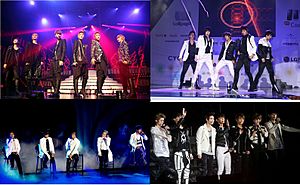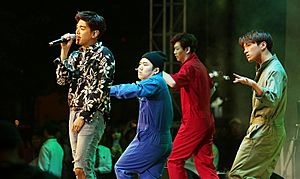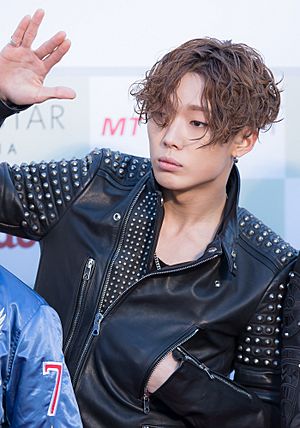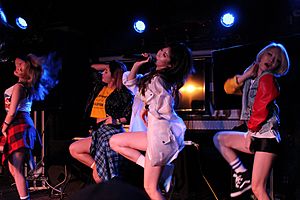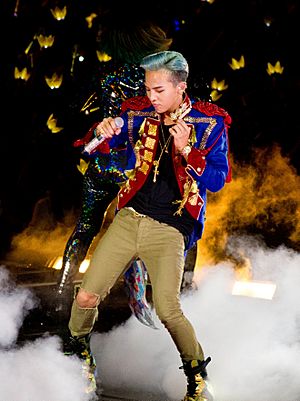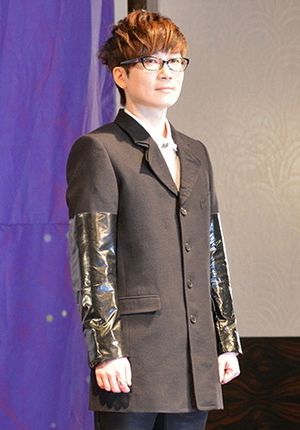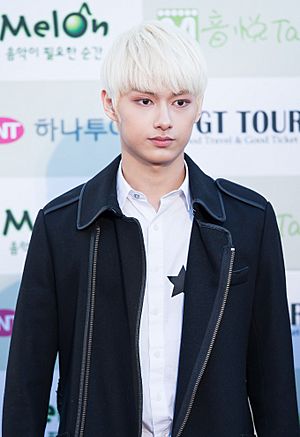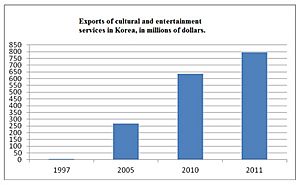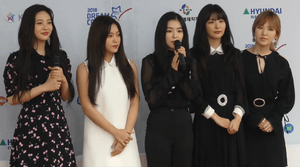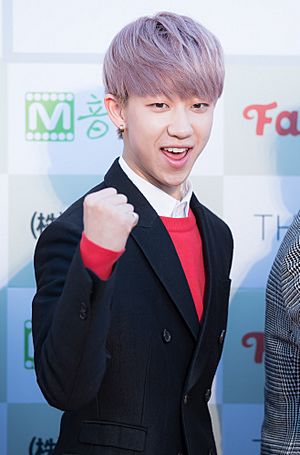K-pop facts for kids
Quick facts for kids |
|
|---|---|
| Stylistic origins | Electronic • Hip hop • Pop • Rock • R&B • Dance • Bubblegum pop |
| Cultural origins | Mid to late 1990s, South Korea |
| Typical instruments | Vocals • Drum pad • Drums • Electric bass • Keyboards • Piano • Sampler • Sequencer • Synthesizer • Occasional use of various other instruments |
K-pop (short for Korean pop) is a popular music style from South Korea. It uses many different sounds and visuals. While K-pop has been around since the early 1990s, the name "K-pop" became very popular in the 2000s. Before that, people often called Korean pop music "Gayo."
K-pop usually means "popular music" in South Korea. But it also describes a newer type of Korean pop music. This modern K-pop mixes styles from all over the world. It includes sounds like jazz, hip hop, R&B, reggae, and electronic dance. It also keeps some of its unique traditional Korean music roots.
The modern K-pop sound really started with the group Seo Taiji and Boys in 1992. They tried out many different music styles. They also added foreign music elements. This helped to change and update South Korea's music scene.
The idea of K-pop "idols" began with the boy band H.O.T. in 1996. K-pop then grew into a big subculture. It gained huge fan groups of teenagers and young adults. After a quiet period for K-pop, groups like TVXQ and BoA started a new wave of idols in 2003. These artists helped K-pop become popular in Japan. They continue to make K-pop famous around the world today.
Thanks to online social networking services and Korean TV shows, K-pop is now known globally. This spread of Korean entertainment is called the Korean Wave. You can see it not just in East and Southeast Asia, but also in Latin America, India, North Africa, the Middle East, and the Western world. K-pop now has a huge audience worldwide.
Contents
How K-Pop Artists Train
Music companies in South Korea offer special contracts to young artists. Sometimes, these artists are very young when they start. Trainees live together and follow a strict schedule. They spend many hours each day learning music, dance, and foreign languages. They also learn other skills to get ready for their debut. Some people in Western media criticize this strict training system. In 2012, The Wall Street Journal reported that training one Korean idol at S.M. Entertainment cost about US$3 million.
K-pop is more than just music; it shares "values, identity and meanings." It mixes Western sounds with an Asian way of performing. Many believe K-pop's global success comes from its shared values. For example, K-pop idols are known for their high-quality performances. They also show a strong work ethic and polite behavior. This is all thanks to their long training period.
Marketing K-Pop Groups
Many K-pop companies introduce new idol groups with a "debut showcase." This means they use online videos and TV shows to promote the group. They don't usually use radio much at first. Groups are given a name and a "concept." This concept is the visual and musical theme they use when they first start or when they release new music. Concepts can change, and fans often see differences between boy group and girl group concepts.
Concepts can be general, like "cute" or "fantasy." New idol groups often start with a well-known concept to help them succeed. Sometimes, smaller groups called "sub-units" are formed from existing members. For example, Super Junior-K.R.Y. has members Kyuhyun, Ryeowook, and Yesung. Super Junior-M became one of the most popular K-pop sub-groups in China.
Online marketing is very important. Music videos are posted on YouTube to reach fans all over the world.
Amazing Choreography
Dance is a huge part of K-pop. When many singers perform together, they often switch places while singing and dancing. They make quick, synchronized movements. This is called "formation changing." K-pop choreography often includes a "point dance." This is a catchy, repeated dance move that matches the song's lyrics.
Super Junior's "Sorry Sorry" and Brown Eyed Girls' "Abracadabra" are famous for their "point" choreography. When choreographers create a dance, they must think about the song's speed. They also consider if fans can easily learn the steps. This means K-pop choreographers often simplify movements.
The training for K-pop idols to dance well is very intense. Dance schools like Seoul's Def Dance Skool help young people develop their dance skills. This gives them a chance to become an idol. Physical training is a big focus at these schools. Students spend much of their time dancing and exercising. Entertainment companies are very picky, so only a few make it to fame. Students must dedicate their lives to mastering dance. This prepares them for the tough routines K-pop groups perform. If they are chosen, the training continues with the company.
K-Pop Fashion
K-pop has a big impact on fashion in Asia. Young fans often follow trends started by their favorite idols. Some idols, like G-Dragon and CL, are known as fashion icons. CL has even worked with famous designer Jeremy Scott.
There are some concerns about beauty trends popularized by the industry. For example, the focus on very pale skin has been criticized. This is because it promotes a narrow idea of beauty.
When Seo Taiji and Boys started in 1992, they changed Korean music. They added rap and American hip-hop styles to their songs. This Western influence also showed in their clothes. The band wore hip-hop fashion. Many groups that came after them copied this style. Groups like Deux and DJ DOC also wore popular hip-hop clothes. They wore baggy pants, sportswear, and bandanas.
As Korean pop music became popular with young people, new idol groups appeared in the mid-to-late 1990s. They wore matching outfits that showed the popular youth fashion trends. Hip-hop fashion was very popular in the late 90s. Idol groups like H.O.T. and Sechs Kies wore this style for their first songs. Accessories made the idols' style special for performances. They used ski goggles, headphones around their necks, and oversized gloves. These gloves helped make their dance moves stand out.
H.O.T.'s 1996 hit "Candy" shows how much thought went into idol costumes. Each member wore a specific color. They also used face paint, fuzzy mittens, visors, and earmuffs. They even used stuffed animals and backpacks as props. Male idol groups had similar colors and styles in their outfits. But each member's outfit still looked a bit different. Female idol groups in the 90s often wore very similar costumes. Their early outfits aimed to show an innocent and youthful image.
K-pop fashion has changed a lot over the years. The "ulzzang" style became popular with K-pop. This look includes big, delicate eyes, a tiny nose, and smooth, pale skin. A small, sharp chin to create a "V-line" face is also desired. This look is hard to get naturally. So, things like colored contact lenses, plastic surgeries, and skin-lightening products became popular. From the late 2000s, K-pop mixed Western and Asian cultures. This made fashion trends in K-pop very diverse. Here are some fashion trends from the late 2000s to early 2010s:
- Street: This style focuses on being unique. It uses bright colors, mixed patterns, and graphic prints. Sports brands like Adidas and Reebok were common (e.g., 2NE1-Fire, SHINee-Ring Ding Dong).
- Retro: This style brings back old looks from the 1960s to 1980s. It uses polka dots and detailed patterns. Common items include denim jackets, boot-cut pants, and scarves (e.g., Wonder Girls-Nobody, Tiara-Roly Poly).
- Cute: This style highlights being feminine or masculine. Outfits use satin, lace, fur, and leather. Common clothes are mini skirts, corsets, and high heels (e.g., Girls' Generation-The Boys, TVXQ-Mirotic).
- Black & White: This style looks modern and chic. It shows elegance and charm. It is often used for formal wear (e.g., Girls' Generation-Genie, Super Junior-Sorry Sorry).
- Futurism: This style is often seen with electronic and hip-hop music. It uses bright colors and metallic details. It aims to look like something from the future (e.g., 2NE1-I am the Best, NCT U-Seventh Sense).
Government Support for K-Pop
The South Korean government knows that K-pop helps the country's exports. The Korean Wave makes Korean products more popular. The Ministry of Culture, Sports and Tourism helps spread K-pop around the world. They set up Korean Cultural Centers in many countries. South Korean embassies also hold K-pop concerts outside the country. The Ministry of Foreign Affairs often invites K-pop fans from other countries to the yearly K-Pop World Festival in South Korea.
The South Korean government also uses K-pop to build good relationships with other countries. A good example is the Mnet Asian Music Awards (MAMA). In 2014, the Korean president at the time, Park Geun-hye, opened the MAMA awards in Hong Kong. This event helped South Korea improve its image and influence around the world.
Another recent example is K-pop singers performing in North Korea. Korean pop singers had visited North Korea before, but these visits stopped in 2005. Then, in 2018, about 190 South Korean performers went to Pyongyang, North Korea. Famous musicians like Red Velvet, Lee Sun-hee (singer), and Cho Yong-pil performed there. Even Kim Jong-un attended as an audience member.
The Rise of Hallyu in the 21st Century
K-pop's growing popularity is part of Hallyu, or the Korean Wave. This means South Korean culture is becoming very popular in other countries. K-pop songs are appearing more and more on Western music charts, like Billboard. Online social media has been key for the Korean music industry to reach a wider audience. The South Korean government supports K-pop as a way to share Korea's culture and influence with young people overseas. In 2014, the British magazine The Economist called Korean pop culture "Asia’s foremost trendsetter."
K-pop has created a whole industry. This includes companies that make music, plan events, distribute music, and sell merchandise. The three biggest companies in K-pop are S.M. Entertainment, YG Entertainment, and JYP Entertainment. They are often called the 'Big Three'. These record labels also act as agencies for their artists. They find new artists, pay for their training, and manage their music and public relations. Currently, S.M. Entertainment has the largest share of the market. In 2011, the Big Three companies, along with others, started a joint company called United Asia Management.
K-Pop on Music Charts
Korean music charts include the Gaon Digital Chart and the Billboard K-pop Hot 100. Some K-pop songs have also appeared on Japan's Oricon Albums Chart and the US Billboard Hot 100.
In 2009, singer Hwangbo had success in Europe. Her song "R2song" reached number 1 on JunoDownload, a big dance music site. She was successful in the UK, Europe, and Korea. She was the first Asian artist to do this.
In May 2014, Exo became the third K-pop act to enter the Billboard 200 chart that year. Before them, 2NE1, Girls' Generation, and Wonder Girls were the first K-Pop acts to chart on the Billboard 200.
In October 2016, BTS's album Wings was the first Korean album to chart in the UK Album Charts, reaching #62. It also became the highest-charting K-pop album on the Billboard 200. In February 2017, BTS's album You Never Walk Alone reached #61 on the Billboard 200. In September 2017, their album Love Yourself: Her reached #14 on the UK Album Charts. Love Yourself: Tear debuted at number one on the US Billboard 200. It was the first K-pop album to top the US albums chart. Their song "Fake Love" reached number ten on the Billboard Hot 100. This was their highest-charting song and the first K-pop group song in the top ten. In August 2020, their song "Dynamite" topped the Billboard Hot 100. It was the group's first number-one song in the US. BTS became the first K-pop act to debut at number one on the Hot 100.
In June 2018, Blackpink became the first K-pop girl group to reach the top 50 of the Billboard 200 album chart. Their mini-album SQUARE UP debuted at No. 40. Their song "Ddu Du Ddu Du" charted at No. 55 on the Billboard Hot 100. It was the highest-charting song by a K-pop girl group sung fully in Korean. Since then, they broke their own record with "Ice Cream" reaching #13 on the Billboard Hot 100.
K-Pop Culture
K-pop artists are often called idols or idol groups. Groups usually have a leader, who is often the oldest or most experienced member. The leader speaks for the group. The youngest group member is called the maknae (Korean: 막내; RR: mangnae; lit. the youngest in a family). This term became popular in Japan because of the boy group SS501. They used it to call their youngest member Kim Hyung-jun man'ne (マンネ). This helped tell him apart from their leader, Kim Hyun-joong, who had a similar name.
K-Pop Fans and Their Appeal
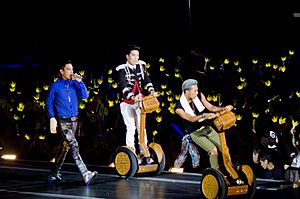
Many fans travel overseas to see their idols perform. Tourists often visit Korea from Japan and China to attend K-pop concerts. In 2012, a K-pop tour group from Japan brought over 7,000 fans to Seoul to meet the boy band JYJ. During JYJ's concert in Barcelona in 2011, fans from many parts of the world even camped overnight to get in. A 2011 survey found that there were over 3 million active members in Hallyu fan clubs.
Bang Si-hyuk, the person behind BTS, said that K-pop idol fans see their idols differently. Fans want to feel close to their idols' lives, even when they are not performing.
An article by The Wall Street Journal said that K-pop's future depends on its fans. Their online activities have grown into "micro-businesses." K-pop groups often have special fan clubs with a unique name and sometimes a color. They also release merchandise for their fans. For example, TVXQ fans are called 'Cassiopeia,' and their color is 'pearl red.' Some popular groups have special light sticks for concerts. For instance, Big Bang fans hold yellow crown-shaped light sticks.
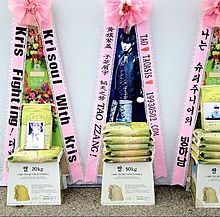
Fan clubs sometimes do charity events to support their idols. They buy bags of 'fan rice' to show their support. These rice bags are then given to people in need. According to Time, for one of BigBang's shows, 12.7 tons of rice were donated by 50 fan clubs worldwide. There are businesses in Korea that specialize in shipping rice from farmers to concert venues. Another way fan clubs show their dedication is by sending lunch to idols during their busy schedules. There are even catering companies in South Korea just for this purpose. More and more, fans are also getting involved in activism outside of the K-pop community.
A unique part of K-pop fandom is the "fan chant." When an idol group releases a new song, fans at live concerts perform chants. These chants usually include the names of the group members. They are done during parts of the song where no one is singing.
Images for kids
-
Marilyn Monroe entertaining American soldiers in Korea in 1954
-
Girls' Generation at SM Town Live NY in 2011
-
2NE1 at a press conference in Manila
-
Rain at the 2011 Time 100 gala in New York City
See also
 In Spanish: K-pop para niños
In Spanish: K-pop para niños


